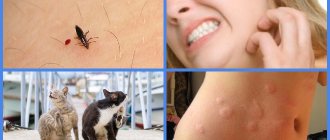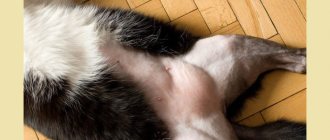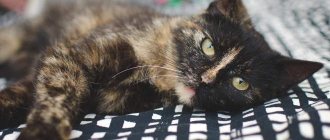One of the most common types of insects that parasitize mammals is fleas. Basic information:
- without wings;
- size from 1 to 5 mm;
- jump up to 0.5 meters;
- feed on the blood of the mammal on which they live;
- The female lays eggs, from which the larva emerges. The larva then makes a cocoon for itself and after a while pupates. The final stage of the life cycle is the transformation of the pupa into an adult.
Cats can get fleas not only when they are kept outside, but also when they live permanently with a person in an apartment or house. Therefore, every owner must be able to promptly recognize parasites and be able to remove them without harm to the health of the pet.
Danger of insect parasites:
- are carriers of helminths, infecting animals and, often, humans;
- the saliva of these insects can cause an allergic reaction;
- bites are accompanied by itching, which causes scratching on the body. These wounds turn into entrance gates for infection of the body with pathogenic microflora from the external environment;
- numerous insects are capable of drinking large amounts of blood, which for small kittens inevitably ends in anemia;
- Constant scratching causes nervousness, which leads to destabilization of mental health.
It’s quite easy to protect your furry friend from these problems by using the advice of experts, as well as pharmaceuticals and folk recipes.
Reasons for appearance
A comfortable temperature for the life of parasitic insects is from 20 to 30 degrees. Therefore, they can live in the basements of apartment buildings, and from there move into the entrances and apartments. Consequently, not only street animals, but also those living with people can “catch” these parasites.
The main ways fleas appear in domestic cats are:
- introduction of larvae or adults from the street on clothing and shoes;
- transmission from another mammal that has these parasites (dogs, mice, rats, etc.). It is worth noting that when living outside the city and keeping livestock, the infection rate increases tenfold.
Important: parasitic insects can live on all pets, so without treatment (or if it is not carried out regularly), cross-infection is possible. They do not live on humans, but they can bite.
Eliminating the consequences of infection
To eliminate the consequences of flea infestation in the form of bites, you can use folk remedies. First you need to disinfect the bite sites with iodine, alcohol or antibacterial soap. Then you can apply a piece of ice or gauze soaked in cold water to the bite site. A longer lasting result is achieved by using Fenistil gel or Psilobalm. In addition to them, you can use tea tree oil, strong tea leaves or chamomile decoction. Soak a cotton pad in the liquid and apply to the bite areas.
How to remove fleas at home
The history of cohabitation between humans and representatives of the cat family goes back more than one millennium. During this time, scientists have invented and improved many methods to get rid of fleas from cats. Today, the most effective is the use of insecticides.
Important
: insecticidal preparations with a high concentration of the active substance should not be used to treat pregnant and lactating females, kittens under three months of age, elderly and sick animals. Insecticides should be used with extreme caution for pets with a history of allergic reactions (regardless of the type of allergen).
Specialists at the Jungle veterinary clinic advise not to treat your pet yourself, especially if your furry friend suffers from chronic diseases such as oncology. Only a qualified veterinarian can adequately assess the state of his health and, depending on the specific situation, prescribe the optimal therapy for removing fleas from a cat with effective drugs. If necessary, the doctor will also prescribe vitamins and immunomodulators to strengthen the immune system, because a weakened body suffers from the consequences of bites much more than a healthy one.
Basic rules for removing parasites
:
- the dosage of medications used depends on the weight and age of the pet;
- It is imperative to adhere to the recommendations specified in the annotation for the drug, and also pay attention to the expiration date of its action. Otherwise, you can cause irreparable harm to your four-legged pet.
Before using any flea insecticide for the first time, you need to check your pet's reaction to it. Intolerance may occur. And this can result in suffocation and even death. Therefore, a few hours before the sanitary procedure, spray the spray on a small area of hair or drop a drop of liquid product. If within a couple of hours the cat does not start sneezing, tears, nasal discharge, or skin rashes appear, then everything is in order and treatment can be carried out.
The principle of action of the drugs
Drops are applied to the pet's skin. After this, the drug penetrates the sebaceous glands and hair follicles. Some of them remain in the fatty layer of the skin, but they do not enter the bloodstream.
The operating principle of most drops is the same. The tick bites through the skin and receives a portion of the medicine inside. The active components quickly block the passage of nerve impulses in the parasite, which leads to its complete paralysis and death.
INTERESTING! The tablets work from the inside. The active substances are absorbed into the blood and then act on the parasites, blocking the functioning of their nervous system.
How to withdraw
Insecticides to kill blood-sucking insects are produced by pharmaceutical companies in a variety of forms:
- drops on the withers;
- sprays applied to the entire surface of the coat;
- special shampoos;
- collars for constant wear.
Next, let's look at each type of anti-flea therapy in a little more detail.
If, after treatment, the cat’s fleas have not disappeared, then the reason may lie in the following:
- This drug may not be suitable for your pet. In this case, you should pay attention to a product containing another active substance;
- the medicine or collar turned out to be counterfeit or expired;
- cross-contamination from other animals has occurred.
Drops
The drip method of application is recognized by veterinarians as the most convenient and safe, and therefore is recommended for independent use with careful adherence to the rules of use. Both long-haired and short-haired pets can be treated this way.
The following effective substances have been developed and used for the production of drops:
- selemectin;
- fipronil;
- eprinomectin;
- imidacloprid;
- moxidectin;
- fospretil;
Brief instructions on how to remove fleas from a cat using pharmacological anti-flea drops:
- if the pet is heavily soiled, wash it with pet shampoo at least 3 days before the procedure;
- squeeze the recommended amount of medicinal liquid onto the withers, spreading the undercoat, trying to get the liquid onto the skin;
- For 5 days, the cat should not be washed or allowed outside during rain. This will cause the healing substance to be washed away;
- in case of severe infestation, repeat the procedure after 5 – 7 days.
Our clinic specialists recommend using the following medications:
- "Leopard";
- "Stronghold";
- "Broadline spot-on";
- "Advocate";
- "Celandine";
- "Inspector";
- "Advantage" and others.
A bonus when using drops is the fact that many medications contain substances that can additionally get rid of ticks and helminths. Information about this is indicated in the instructions for use.
The drugs are also available in the form of spray atomizers. The liquid is applied not only to the withers, but also to the entire hairline, avoiding the area of the mouth, eyes and ears. This method of treatment is used only for absolutely healthy individuals who do not have health problems. To prevent the cat from immediately starting to lick the applied medicine, it is recommended to put a high protective collar on it for 10 - 12 hours. Due to possible negative consequences, experts do not recommend sprays for continuous use.
Collar
Special anti-flea collars for cats are not used to destroy blood-sucking parasites, but to repel them. Therefore, these accessories are recommended to prevent the emergence of a new generation of parasitic insects. In this case, cats must be pre-treated with other anti-flea agents: drops, spray and others. Wearing a collar is more a preventive measure than a treatment measure.
The period during which the collar is effective is approximately 1 month. After this period has expired, experts recommend replacing the old accessory with a new one. Expensive samples are valid for up to 8 months.
Veterinary pharmacies offer collars in a wide range:
- "Leopard";
- "Celandine";
- "VEDA";
- "Doctor ZOO";
- "Foresto";
- «RolfClub;
- "Dana Ultra";
- "BioVax";
- "Inspector" etc.
These healing accessories are universal, you need to adjust the size when putting them on.
Soaps and shampoos
Treating your cat for fleas with special purpose shampoos and soaps is a popular, safe and inexpensive way to control parasites. But it should be borne in mind that this method cannot cope with a critical level of infection. In this case, the specified method has an auxiliary value. It is recommended to use drops or spray as the main remedy.
All shampoos are divided into therapeutic and preventive. The first option kills insects, while the second only repels insects. Therefore, it makes no sense to use prophylactic shampoo for an infected individual.
How to get rid of fleas on a cat using medicated shampoo:
- if there are matted tangles on the wool, then before the hygiene procedure you should try to comb them, and if you can’t do this, then cut them;
- then you need to thoroughly moisten the entire fur with water, being careful not to get the liquid into your eyes and ears;
- then you need to distribute a little shampoo or soap foam over the entire coat and massage it a little;
- Next, you should thoroughly rinse your pet several times with running water;
- After bathing, you need to blot the wet coat with a towel and, when it dries, comb it with a fine-toothed comb. This is necessary in order to remove unwashed insects.
The advantage of detergents is that they can be used for bathing pregnant and lactating females, as well as small kittens and individuals at risk. When purchasing shampoo, you must choose the type whose annotation states that it can be used for a specific category of the cat family.
Folk remedies
If your pet doesn’t have a lot of flea parasites (he rarely itches) or you want to carry out prevention, then you can use time-tested recipes.
How to remove fleas from a cat at home using inexpensive folk remedies and remedies:
- compress from a decoction of wormwood or geranium. Boil 5 tablespoons of crushed dry plant for 20 minutes in 250 ml of water. After the broth has cooled, apply it to the cat's hair and wrap the animal in a towel for 15 minutes. After the specified time, unroll it over the bathtub (insects will jump out of the wool and towel). Then you need to carefully comb the fur to remove eggs and larvae. It is recommended to repeat the procedure every few days to completely destroy the parasites. Dried crushed wormwood can be bought at any pharmacy;
- bathing with salt. To do this, dissolve 100 g of ordinary salt in 1 liter of warm water. Then the resulting solution is stirred in a basin in a volume of water sufficient to lay (position, sit) the animal so that the head remains on the surface and the entire body is under water. Having placed your pet in the prepared “bath”, keep it there for about 10 minutes. Then be sure to wash the hair with baby soap, rinse and dry. The last step is to comb the dead fleas out of your cat's fur. The procedure must be carried out several times with an interval of 2 - 3 days until all parasitic insects are exterminated.
Fleas appear again and again: reviews and examples
As mentioned above, it is important not to forget that fleas jumping on your legs are only a visible part of the problem. Scattered eggs (7 days), as well as larvae (10 days) and pupae (7-12 days), hiding in carpet pile, floor crevices and other hard-to-reach places are the least vulnerable. Most of them enter the stage of adult fleas just when the effect of the product has already weakened. And it doesn’t matter which preparation from the proposed list you used to treat the room. To eradicate parasites, especially in an overly infested area, it is recommended to treat every 7-12 days. This is how long the period of the “incubation” cycle of the pupa lasts.
By fresh bites and jumping individuals, it can be determined that the transition of larvae to pupae has passed and ended with the emergence of the next “batch” of new fleas from the cocoons. Of course, some of the eggs and larvae will be collected with a vacuum cleaner after the first disinfestation. But if we do not want history to repeat itself, then the next processing is inevitable, and it must be timely. And in order to react immediately, it is important to observe. Traps will help a lot when it comes to observations.
Let's look at real examples:
Obviously, the problem cannot be solved in one day. What time you should prepare yourself for depends on the sanitary and hygienic condition (temperature, humidity, technical condition of the house and the number of fleas). If you managed to prevent or at least “detect” a jump in numbers in time, then 1-2 treatments will be enough to forget about the parasites forever. In the example below, the fleas disappeared immediately:
In some situations it will take a month or a month and a half. Don't despair if it takes a long time. If fleas have developed “immunity,” then self-treatment becomes a useless exercise. For example, like here:
Obviously, the situation requires immediate intervention by the sanitary service (disinsection service). It is important not to forget: in direct proportion to time, money expenses will increase. The faster and more carefully the efforts are made, the cheaper the result achieved. And vice versa.
Having only up to 400 rubles in your wallet and available means, you can count on 2 weeks of unscheduled pest control and cleaning, and if the situation is not yet too advanced, then on the high efficiency of the measures taken. Good luck and complete withdrawal!
Prevention
To prevent the appearance of fleas in a cat, you can use some of the remedies listed above. For example, periodic washing with shampoo and soap or wearing a special collar.
In addition, it is necessary to take into account that the sleeping place of an infected animal (bedding, floor, carpet) is also inhabited by parasites. Therefore, the cat should be treated and its bed disinfected at the same time. This is important to prevent the risk of re-infection.
Disinfection of the premises where the animal lives is also mandatory. It can be done using special products sold in pet stores. It is necessary to treat not only the floor, but also upholstered furniture, curtains, and baseboards. If it is difficult to do this yourself, then it is worth inviting disinfection specialists.
Among the folk recipes for prevention, you can use the effective method of repelling insects with wormwood. To do this, place dry or fresh branches of the plant under the bedding on the sleeping area.
On a note
: washing the floor with a strong decoction of wormwood will help prevent the appearance of parasitic insects in an apartment or private house if treating the floor with disinfectants is impossible for some reason. For example, if there is an allergy sufferer in the family or a baby who is still learning the world at a crawl.
Fleas on a cat are not forever. This problem can and should be solved promptly, without leading to serious ailments. Experienced veterinarians at the Jungle Clinic will help treat your four-legged pet, regardless of the severity of the clinical case.
Features of the insect
There are different types of fleas, and the choice of remedy depends on what type of insect you encounter. They are divided into:
- Mouse and rat;
- Dogs and cats;
- Sandy;
- Basement, earthen;
- Bedding.
We are interested in cat fleas. How are they different from others, what do they look like? Body length usually ranges between two and five millimeters. The exception is the fertilized female, its length can reach 15 mm. The dark brown body of the insect is densely covered with bristles, which make it easy to move along the animal’s fur.
The main difference between a cat flea and a dog or rat flea is the flattened forehead and close-set eyes.
Why are fleas dangerous?
The main danger of fleas is not the inconvenience it brings to the animal, but the spread of infections. With its bites, a flea can transmit more than 200 types of dangerous diseases. Some of them are dangerous, including for people.
That is why you need to start fighting as soon as possible. The earlier you identify the parasite, the greater the chances of dealing with it with little blood.
Symptoms of infection
It is quite difficult to miss the moment of flea infestation: the animal immediately begins to show anxiety and itch. Swelling and red blisters appear at the bite sites. It’s easy to identify an infestation—just part the animal’s fur and carefully examine the skin. You can also find larvae when combing your pet.
Rating of the best flea drops for cats
| Nomination | Place | Name | Price |
| The best domestically produced flea drops | 1 | Inspector Total K | 420 ₽ |
| 2 | Leopard | 85 ₽ | |
| 3 | Agrovet protection 4 with tail | 80 ₽ | |
| 4 | Celandine Bio | 195 ₽ | |
| 5 | Ms.Kiss | 190 ₽ | |
| The best imported flea drops | 1 | Zoetis Stronghold | 605 ₽ |
| 2 | MSD Animal Health Bravecto Spot On | 1 550 ₽ | |
| 3 | UltraGuard Plus Drops | 1 300 ₽ | |
| 4 | Bravecto Spot On | 1 300 ₽ | |
| 5 | Advantage (Bayer) | 280 ₽ | |
| 6 | Frontline Combo | 980 ₽ |
Types of funds
In pet stores you can buy antiparasitic drugs in various forms:
- drops on the withers;
- shampoos;
- sprays;
- powders;
- collars;
- solutions for injections, room treatment.
They are used separately or combined. For example, they treat the cat with drops and put on a collar to prevent re-infestation.
Room treatment
The same groups of drugs are used as for treating animals. FOS and cyanopyrethroids have proven themselves well for treating premises. But first, mechanical cleaning is used with a vacuum cleaner (paying special attention to cracks, upholstered furniture, back walls of cabinet furniture), wet cleaning and only then products. You can use several drugs at the same time, or you can use just one. Keep in mind: you will need both a liquid diluted in water to wash the floor so that the water and product flows into the cracks, and sprays. If the flooring is sensitive to excessive moisture, then a spray can be used to treat the baseboards.











